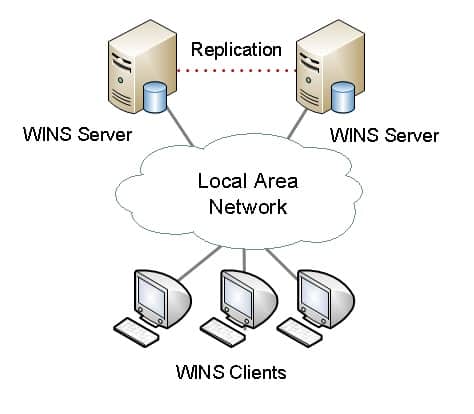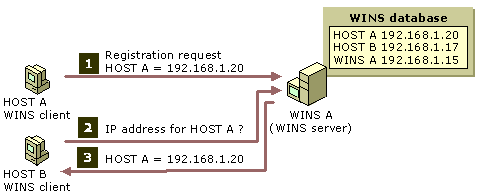Definition of Windows Internet Name Service (WINS) in Network Encyclopedia.
What is WINS (Windows Internet Name Service)?
Windows Internet Name Service, or WINS, is a Microsoft Windows service that dynamically registers NetBIOS names of computers on the network.

Windows Internet Name Service (WINS) provides a distributed database for registering and querying dynamic mappings of NetBIOS names for computers and groups used on your network. WINS maps NetBIOS names to IP addresses and was designed to solve the problems arising from NetBIOS name resolution in routed environments. WINS is the best choice for NetBIOS name resolution in routed networks that use NetBIOS over TCP/IP.
NetBIOS names are used by earlier versions of Microsoft® Windows® operating systems to identify and locate computers and other shared or grouped resources needed to register or resolve names for use on the network.
NetBIOS names are a requirement for establishing networking services in earlier versions of Microsoft operating systems. Although the NetBIOS naming protocol can be used with network protocols other than TCP/IP, WINS was designed specifically to support NetBIOS over TCP/IP (NetBT).
WINS simplifies managing the NetBIOS namespace in TCP/IP-based networks. The following illustration shows a typical series of events involving WINS clients and servers.
How Windows Internet Name Service Works
In order for NetBIOS hosts (servers and clients running pre-Windows 2000 versions of Microsoft Windows) to communicate on a network, their NetBIOS names must first be resolved into IP addresses. WINS servers perform this task. Using WINS servers instead of broadcasts to perform NetBIOS name resolution has several advantages:
- Directed traffic to WINS servers generates less network traffic than broadcasts.
- WINS provides a mechanism for browsing network resources across multiple domains and subnets.
- The WINS database of NetBIOS name to IP address mappings is dynamically maintained, eliminating the need for lmhosts files on clients.
WINS works by requiring each NetBIOS host to register its NetBIOS name to IP address mapping on the WINS server by using a process called name registration. These mappings are temporarily stored in a database called the WINS database and need to be renewed periodically by way of a process called registration renewal. If the IP address of the NetBIOS host changes, the WINS database is automatically updated accordingly. And when a NetBIOS host is shut down, a name release occurs, removing the host’s associated mapping from the WINS database.

In this example, the following occurs:
- A WINS client, HOST-A, registers any of its local NetBIOS names with WINS-A, its configured WINS server.
- Another WINS client, HOST-B, queries WINS-A to locate the IP address for HOST-A on the network.
- WINS-A replies with the IP address for HOST-A, 192.168.1.20.
WINS reduces the use of local IP broadcasts for NetBIOS name resolution and enables users to locate systems on remote networks easily. Because WINS registrations are done automatically each time clients start and join the network, the WINS database is automatically updated when dynamic address configuration changes are made.
For example, when a DHCP server issues a new or changed IP address to a WINS-enabled client computer, WINS information for the client is updated. This requires no manual changes to be made by either a user or a network administrator.
On the Windows NT Server platform, you manage WINS by using the administrative tool called WINS Manager. This tool can be used for the following tasks:
- Maintaining the WINS database of NetBIOS name to IP address mappings
- Configuring WINS replication between primary and secondary WINS servers
- Creating static mappings for non-WINS computers
On the Windows 2000 Server platform, you manage WINS using the WINS snap-in for the Microsoft Management Console (MMC).
In recent versions of Windows Server Microsoft doesn’t recommend WINS deployment. Instead, deploy DNS (Domain Name System). DNS also provides computer name registration and resolution services and includes many additional benefits over WINS, such as integration with Active Directory Domain Services. However, if you really have that need:
These instructions apply to Server 2012 and later.
To install the server:
dism /online /enable-feature /featurename:WINSRuntime /all
To install the GUI:
dism /online /enable-feature /featurename:WINS-Server-Tools /all
WINS explained in video
More than one WINS Server
A single WINS server can support up to about 5000 clients. However, it is a good idea to always use at least two WINS servers in order to provide fault tolerance for NetBIOS name resolution. WINS servers maintain their own separate WINS databases, but they can be configured to replicate their NetBIOS name to IP address mappings by way of a process called WINS database replication.
WINS tools
The primary tools that you use to manage WINS servers are the WINS console and the Netsh WINS commands.
- The Netsh WINS commands: You can type the Netsh WINS commands in a command prompt window at the netsh wins> command prompt, or you can execute the Netsh WINS commands in batch files and other scripts. All of the functionality that is available in the WINS console is available at the netsh wins> command prompt.
- The WINS console: The WINS console is added to the Administrative Tools folder in Control Panel when you install a WINS server running a Microsoft® Windows Server 2003 server operating system. The WINS console appears as a Microsoft Management Console (MMC) snap-in, to further integrate WINS administration into your total network management.